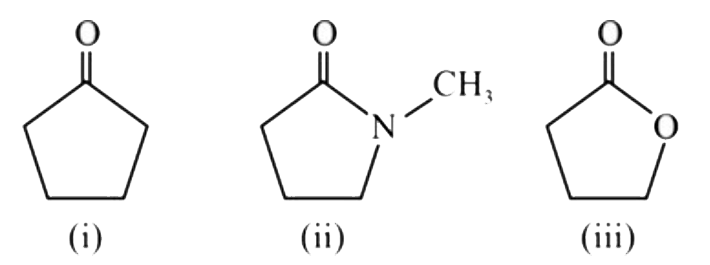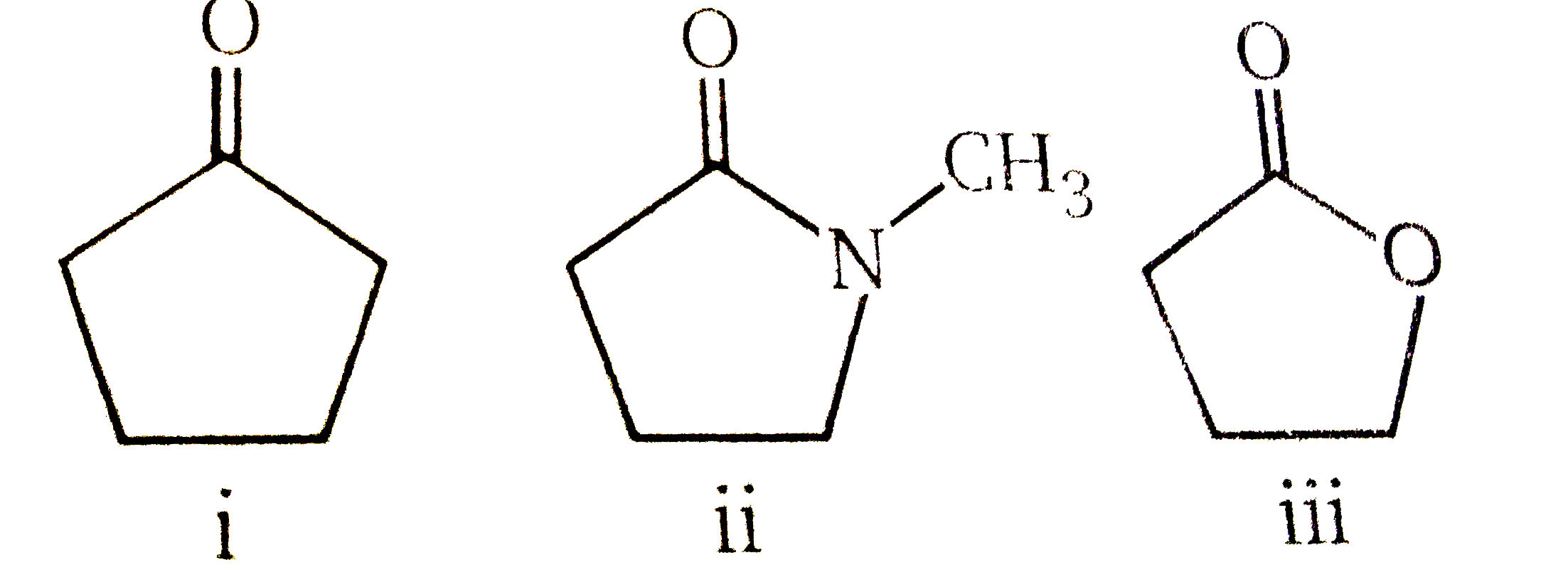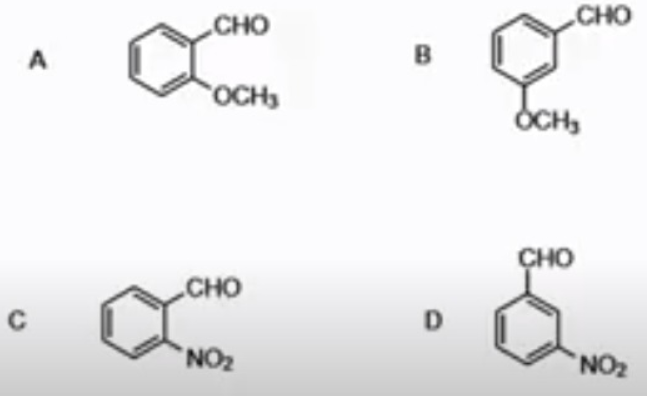Arrange the following compounds in order of increasing reactivity towards HCN :
Acetaldehyde, Acetone, Di-tertiary butyl ketone, Methyl tertiary butyl ketone.
To determine the order of increasing reactivity towards HCN for the given compounds (Acetaldehyde, Acetone, Di-tertiary butyl ketone, and Methyl tertiary butyl ketone), we need to consider the concept of steric hindrance. The more steric hindrance present around the carbonyl carbon, the less reactive the compound will be towards nucleophiles like HCN.
1. Identify the Compounds:
- Acetaldehyde: CH₃CHO
- Acetone: CH₃C(=O)CH₃
- Di-tertiary butyl ketone: (C(CH₃)₃)C(=O)(C(CH₃)₃)
- Methyl tertiary butyl ketone: C(CH₃)₃C(=O)CH₃
2. Analyze Steric Hindrance:
- Acetaldehyde has one alkyl group (methyl) attached to the carbonyl carbon, resulting in minimal steric hindrance.
- Acetone has two methyl groups attached to the carbonyl carbon, which increases steric hindrance compared to acetaldehyde but is still relatively low.
- Methyl tertiary butyl ketone has a bulky tertiary butyl group and one methyl group, leading to significant steric hindrance.
- Di-tertiary butyl ketone has two bulky tertiary butyl groups, resulting in the highest steric hindrance.
3. Rank the Compounds Based on Reactivity:
- The compound with the least steric hindrance will be the most reactive towards HCN.
- Therefore, the order of increasing reactivity towards HCN is:
- Di-tertiary butyl ketone (least reactive)
- Methyl tertiary butyl ketone
- Acetone
- Acetaldehyde (most reactive)
Final Order of Increasing Reactivity:
Di-tertiary butyl ketone < Methyl tertiary butyl ketone < Acetone < Acetaldehyde
- Acetaldehyde: CH₃CHO
- Acetone: CH₃C(=O)CH₃
- Di-tertiary butyl ketone: (C(CH₃)₃)C(=O)(C(CH₃)₃)
- Methyl tertiary butyl ketone: C(CH₃)₃C(=O)CH₃
- Acetaldehyde has one alkyl group (methyl) attached to the carbonyl carbon, resulting in minimal steric hindrance.
- Acetone has two methyl groups attached to the carbonyl carbon, which increases steric hindrance compared to acetaldehyde but is still relatively low.
- Methyl tertiary butyl ketone has a bulky tertiary butyl group and one methyl group, leading to significant steric hindrance.
- Di-tertiary butyl ketone has two bulky tertiary butyl groups, resulting in the highest steric hindrance.
- The compound with the least steric hindrance will be the most reactive towards HCN.
- Therefore, the order of increasing reactivity towards HCN is:
- Di-tertiary butyl ketone (least reactive)
- Methyl tertiary butyl ketone
- Acetone
- Acetaldehyde (most reactive)
Di-tertiary butyl ketone < Methyl tertiary butyl ketone < Acetone < Acetaldehyde
Topper's Solved these Questions
- BOOK - DINESH PUBLICATIONCHAPTER - ALDEHYDES AND KETONES EXERCISE - Question From Board86videos
ALDEHYDES AND KETONES
- BOOK - DINESH PUBLICATIONCHAPTER - ALDEHYDES AND KETONES EXERCISE - Higher Order Thinking Skills6videos
ALDEHYDES AND KETONES
- BOOK - DINESH PUBLICATIONCHAPTER - ALDEHYDES AND KETONES EXERCISE - Problem15videos
ALDEHYDES AND KETONES
- BOOK - DINESH PUBLICATIONCHAPTER - ALCOHOLS AND PHENOLSEXERCISE - Matrix9videos
ALCOHOLS AND PHENOLS
- BOOK - DINESH PUBLICATIONCHAPTER - ALKALI EARTH METALSEXERCISE - Unit test-125videos
ALKALI EARTH METALS
Similar Questions
Arrange the following compounds in increasing order of their property as indicated :
(i) Acetaldehyde, Acetone, Di - tery - butyl ketone, Methyl tert - butyl ketone (reactivity towards HCN)
CH3CH2CH(Br)CH2COOH,(CH3)2CHCOOH,CH3CH2CH2COOH( acid strength).
(iii) Benzoic acid, 4 - Nitrobenzoic acid, 3, 4 - Dinitrobenzoic acid, 4 - Methoxybenzoic acid (acid strength).View SolutionArrange the following compounds in the increasing order of their property as indicated:
i. Acetaldehyde, acetone, di-tert-butyl ketone, methyl tert-butyl ketone (reactivity towards HCN).
ii. CH3CH2CH(Br)COOH,CH3CH(Br)CH2COOH,(CH3)2CHCOOH,CH3CH2CH2COOH (acidic strength).
iii. Benzoic acid, 4-nitrobenzoic acid, 3,4-dinitro-benzoic acid, 4-methoxybenzoic acid (acidic strength).View Solution
Knowledge Check
- Question 1 - Select One
Arrange the following compounds in order of their reactivity towards LiAlH4
 AI<II<IIIBI<III<IICII<I<IIIDII<III<I
AI<II<IIIBI<III<IICII<I<IIIDII<III<I - Question 2 - Select One
Arrange the following compounds in order of their reactivity toward LiAlH4.
 Ai<ii<iiiBi<iii<iiCii<i<iiiDii<iii<i
Ai<ii<iiiBi<iii<iiCii<i<iiiDii<iii<i - Question 3 - Select One
Choose the most appropriate options.
Arrange the following compounds in the increasing order of their reactivity towards HCN
I. Acetaldehyde
II. Acetone
III. Di-tert-butyl ketoneAIII>II>IV>IBII>I>IV>IICIV>III>II>IDII>IV>I>I
Arrange the following compounds in the increasing order of their property as indicated:
i. Acetaldehyde, acetone, di-tert-butyl ketone, methyl tert-butyl ketone (reactivity towards HCN).
ii. CH3CH2CH(Br)COOH,CH3CH(Br)CH2COOH,(CH3)2CHCOOH,CH3CH2CH2COOH (acidic strength).
iii. Benzoic acid, 4-nitrobenzoic acid, 3,4-dinitro-benzoic acid, 4-methoxybenzoic acid (acidic strength).View SolutionAcetone to tertiary butyl alcohol
View SolutionArrange the following compounds in increasing order of reactivity towards nucleophilic substitution:
 View Solution
View SolutionArrange the following in increasing order of reaction with HCN
 View Solution
View SolutionArrange the following compounds in order of increasing reactivity towards nitration (∀KMCP35_N∃TCHEE35012_Q01)
View Solution

